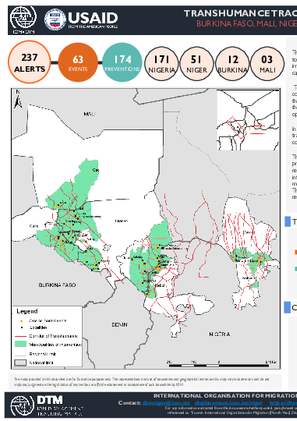-
Countries
-
Data and Analysis
-
Special Focus
-
Crisis Responses
West and Central Africa — Sahel (Burkina Faso), Gao (Mali), Maradi/Tillabéri (Niger) and Katsina/Kebbi/Sokoto (Nigeria) — Transhumance Tracking Tool 2 (July- August 2022)

Contacter
DTM Niger, NigerDataResearch@iom.int, RODakar-DataResearch@iom.int
Langue
English
Emplacement
Niger
Période couverte
Aug 31 2022
Aug 31 2022
Activité
- Flow Monitoring
- Mobility Tracking
The transhumant livestock system is an ancestral practice of pastoralists between Sahelian countries towards coastal countries. These Sahelian countries are faced with vulnerability factors (security crisis, irregular rainfall, competition over natural resources) that threaten their sustainability, weaken their capacity to adapt and provoke tensions between communities that sometimes result in deadly conflicts.
To better understand transhumance movements trends and the impact of vulnerabilities on transhumant communities, IOM has developed the Transhumance Tracking Tool (Transhumance Tracking Tool – TTT) through its Displacement Tracking Matrix DTM, with the Bilital Maroobe Network (RBM) and its members the pastoralist organisations, to monitor transhumance in cross-border areas in countries where RBM operates.
In the framework of this project, the TTT provides an understanding of the dynamics of cross-border transhumance between Burkina Faso, Niger, Nigeria and Mali by combining three components: mapping, counting and alerting.
The purpose of the alert system is to identify events related to the use of natural resources, agro-pastoral practices, and disasters in the cross-border area of different countries, to understand the existing conflict resolution methods, and to inform competent authorities to reduce tensions in the municipalities of intervention. This system makes it possible to identify alerts related to a conflict event (event alert) or to a massive, early, late or unexpected movement of livestock (prevention alert) that could lead to conflict. These alerts, once transmitted to the various actors, are used for conflict prevention or actions towards resolutions. This report presents data from the alert tool for the months of July to August 2022
